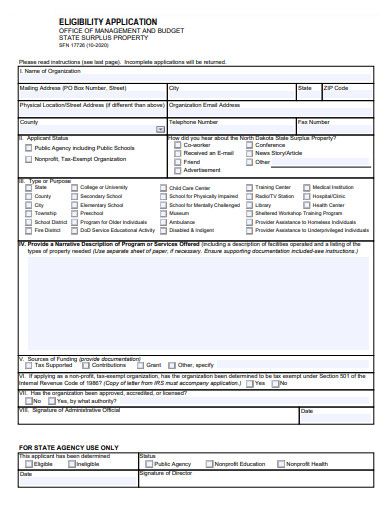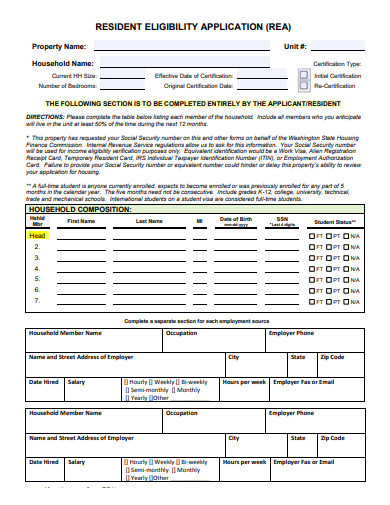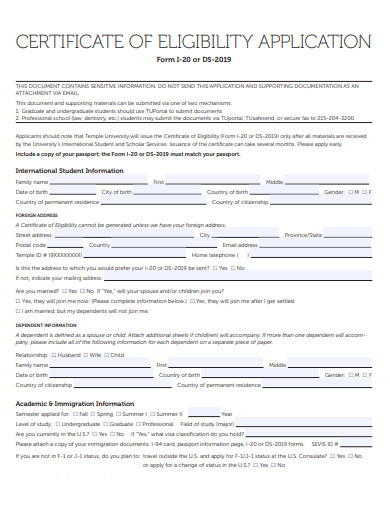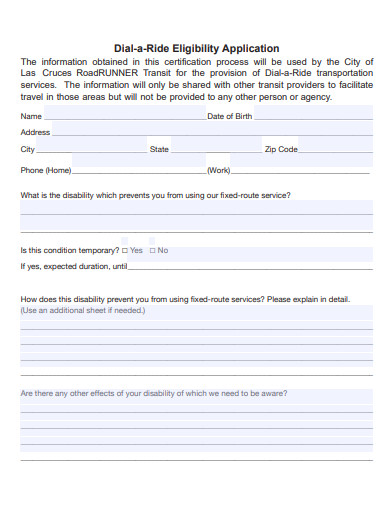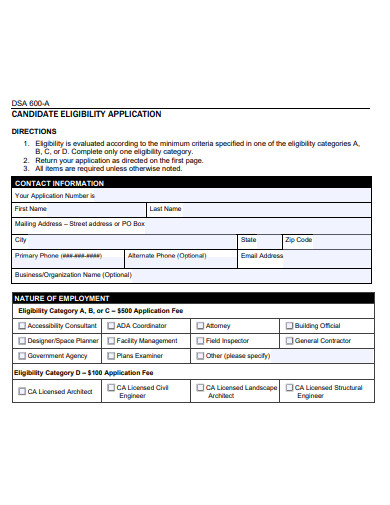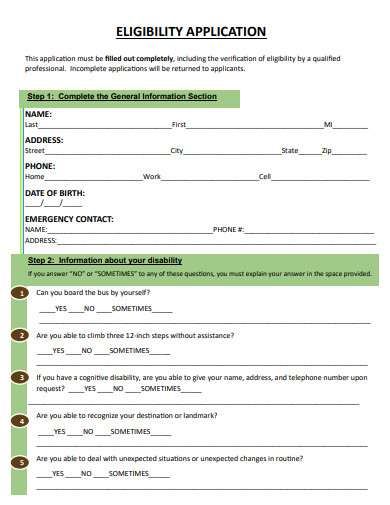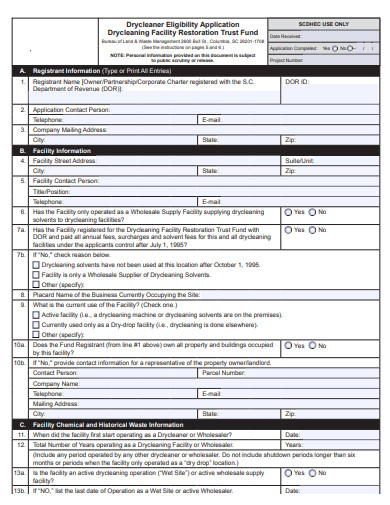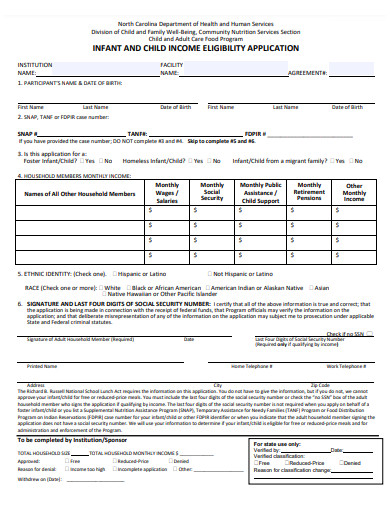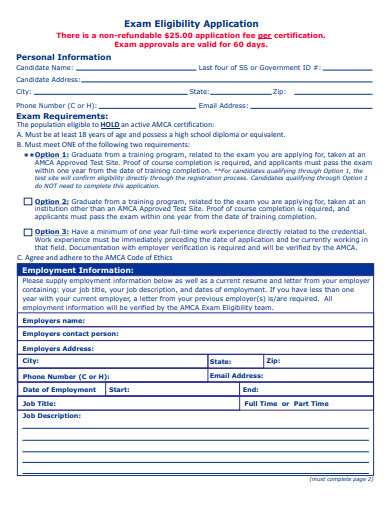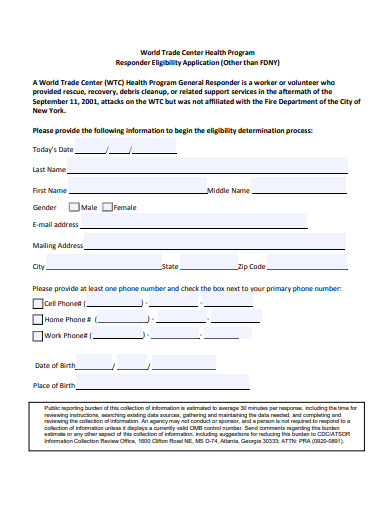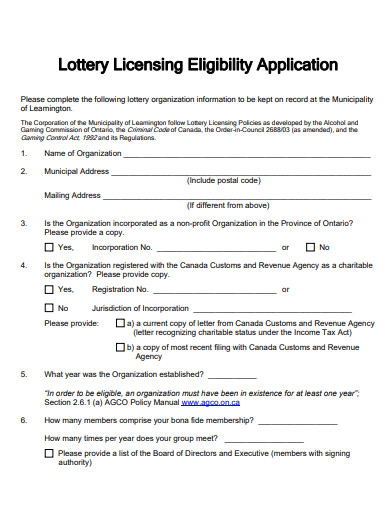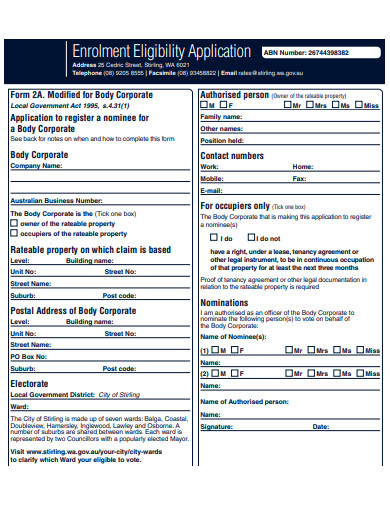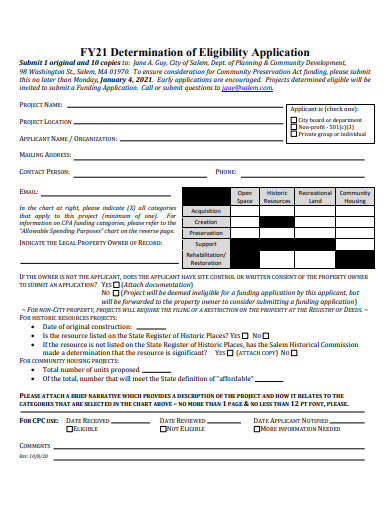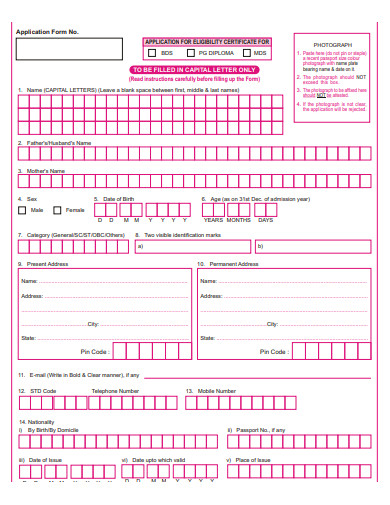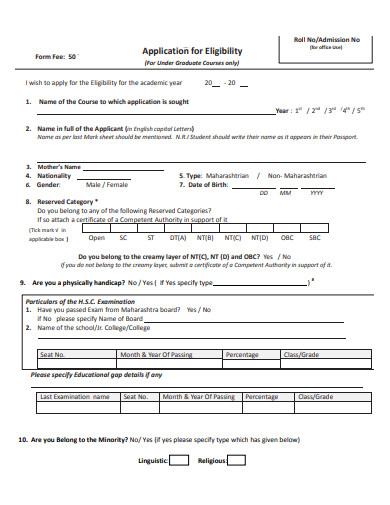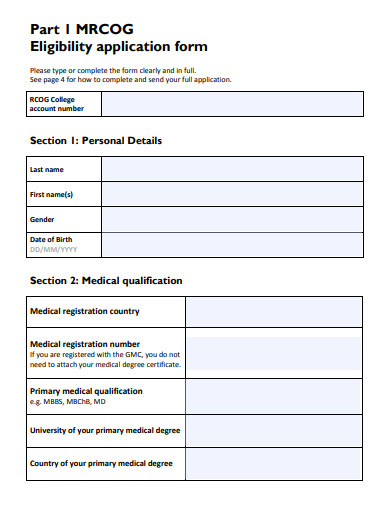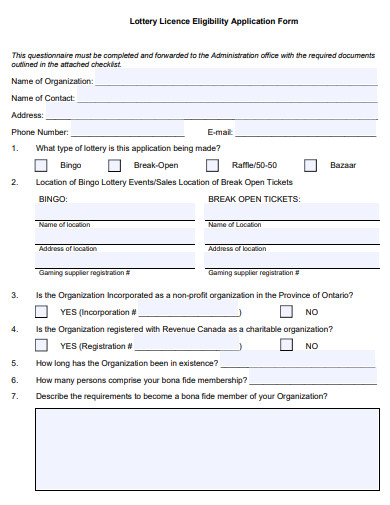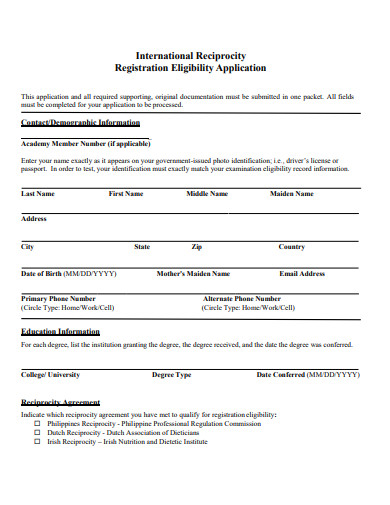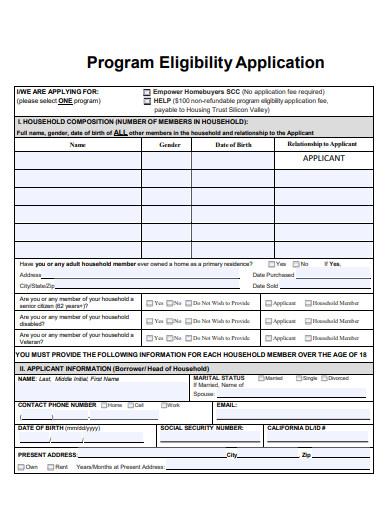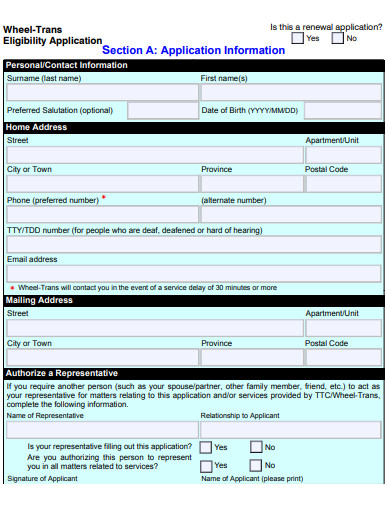In a world where criteria and prerequisites define access, the ‘Eligibility Application’ serves as a critical gateway. Designed to determine qualification for sample programs, benefits, or opportunities, it streamlines the assessment process. Whether it’s for financial aid, specialized programs, or job positions, a thorough Eligibility Application ensures fairness and transparency. Join us as we explore its structure, significance, and the essential role it assumes in ensuring just and efficient sample evaluations.
21+ Eligibility Application Samples
1. Sample Eligibility Application Template
2. Sample Exam Eligibility Application Form Template
3. Sample Resident Eligibility Application Template
4. Sample Certificate of Eligibility Application Template
5. Sample Dial-a-Ride Eligibility Application Template
6. Sample Candidate Eligibility Application Template
What is an Eligibility Application?
Eligibility applications are processes or sample forms that individuals or entities must complete to determine if they qualify for specific programs, benefits, or services. These applications are designed to evaluate an applicant’s qualifications based on set criteria. The concept of eligibility verification is common in sectors like healthcare, education, housing, and social services, among others.
Understanding the Importance of Eligibility
To ensure that resources are allocated appropriately, many institutions and programs have criteria that individuals must meet. Whether it’s financial assistance, admission to a school, or access to specialized services, these criteria help maintain the integrity and purpose of a program.
For example, a scholarship might be offered only to students with a certain GPA or from a specific region. In this case, an eligibility application would help assess which students meet these criteria. You can also see more templates like Blank Job Application.
The Evolution of Eligibility Applications
Eligibility applications have been in existence for decades, serving as gatekeepers to various resources and opportunities. Over time, these format applications have evolved, embracing new technologies and methods to make the process more efficient.
Technological Advancements and Digital Transformation
In the past, eligibility applications were often paper-based, requiring manual submission and sample review. However, the digital age has transformed the landscape:
- Online Platforms: Many institutions now offer online portals where applicants can submit their details, upload documents, and track the status of their applications in real-time.
- Automated Verification: With the integration of databases, some pieces of information, like identity or income, can be verified automatically, reducing processing time.
- Mobile Applications: Recognizing the ubiquity of smartphones, some organizations have developed mobile apps that allow applicants to submit and monitor their applications on the go.
Components of an Eligibility Application
- Personal Information: Almost all eligibility applications will request basic personal details, such as name, age, address, and contact details.
- Proof of Status or Situation: Depending on the program, applicants might need to provide proof of their current situation. This could be financial records, employment status, academic records, or medical process documentation.
- References or Recommendations: Some applications require references or recommendation letters to validate claims or to provide a comprehensive view of the applicant.
- Statement or Essay: Especially for academic or special program applications, a personal statement or essay might be required to gauge the applicant’s motivations and fit for the program.
The Process of Assessment
Once the eligibility application is submitted, it undergoes a review process. This review typically involves:
- Verification: Ensuring all provided information is accurate.
- Comparison: Checking the applicant’s details against the program’s criteria.
- Evaluation: Sometimes, especially for competitive programs, the application will be evaluated in comparison to others.
Potential Challenges in the Application Process
While eligibility applications serve an essential function, they can come with challenges:
- Complexity: Some applications can be extensive and confusing, making it challenging for applicants to complete them correctly.
- Documentation: Acquiring the necessary documentation can be a hurdle, especially if it requires third-party verification.
- Timeliness: The processing time for these applications can vary, sometimes leaving applicants in a state of uncertainty.
Tips for a Successful Eligibility Application
- Be Thorough: Ensure all sections of the application are filled out completely.
- Provide Accurate Information: Always be truthful. Inaccuracies can lead to delays or disqualifications.
- Gather Documents Early: Before starting the application, ensure you have all the necessary documents.
- Seek Assistance: If unsure about any part of the application, seek help. This could be from the institution offering the program or from professionals familiar with the process.
Enhanced Data Security
With the rise of digital applications comes the responsibility of safeguarding personal and sensitive information:
- Encryption: Most online eligibility application platforms employ encryption protocols to protect data transmission.
- Regular Audits: To ensure data integrity and security, frequent system audits are conducted.
- User Authentication: Multi-factor authentication methods are becoming commonplace to prevent unauthorized access.
Customization and Personalization
Modern-day eligibility applications often employ algorithms and AI to offer a more personalized experience:
- Tailored Questions: Instead of a one-size-fits-all approach, applications can adjust questions based on previous answers, making the process more streamlined.
- Predictive Analytics: Some platforms might provide instant sample feedback or predictions on eligibility based on preliminary data, giving applicants an early indication of their standing.
Importance of Continuous Updates
Given the dynamic nature of sample policies, economics, and individual circumstances, it’s essential for eligibility criteria and application processes to be regularly reviewed and updated:
- Changing Economic Landscapes: Factors like inflation, recession, or employment rates can influence eligibility criteria, especially for financial aid or housing programs.
- Legislative Changes: As laws and regulations evolve, eligibility applications must be updated to reflect new legal standards or requirements.
Why is Eligibility Application Necessary?
Eligibility applications play a pivotal role in many sectors and systems worldwide. Their significance stretches across various areas, from education and healthcare to housing and social services. But why exactly is such an application deemed so crucial? Below, we delve into the primary reasons that underscore the importance of eligibility applications.
Resource Allocation and Fair Distribution
- Ensuring Limited Resources Reach the Deserving: Resources, especially in programs offering financial assistance or specialized services, are often limited. Eligibility applications ensure that these resources are allocated to those who meet the defined criteria and truly need them.
- Maintaining Program Integrity: By setting clear eligibility criteria and requiring applications, institutions can ensure that their resources or services are not misused or exploited. This maintains the integrity and original purpose of the program.
Standardization and Transparency
- Consistent Evaluation: Eligibility applications provide a standardized method for assessing all applicants. This ensures everyone is judged based on the same criteria, promoting fairness.
- Transparent Process: A well-defined eligibility application process allows applicants to understand what is expected of them and how decisions are made, fostering trust in the system.
Compliance and Legal Requirements
- Meeting Regulatory Standards: In many sectors, especially those overseen by government bodies, eligibility criteria and the application process are set to comply with legal mandates or policies.
- Avoiding Legal Repercussions: Ensuring only eligible individuals or entities access certain benefits helps institutions avoid potential legal issues or sanctions.
Data Collection and Analysis
- Building a Database: Eligibility applications serve as a rich source of data, helping institutions understand the demographics and needs of their audience.
- Informing Future Decisions: The aggregated data from these applications can be analyzed to make informed decisions about program modifications, resource allocation, or policy changes.
Feedback and Continuous Improvement
- Direct Communication with Applicants: Through the eligibility application process, institutions can directly interact with their target audience, gaining insights into their needs and challenges.
- Improving Services: Feedback from the application process can highlight areas of improvement, be it in the application process itself or the services provided.
Risk Management
- Preventing Fraud: A rigorous eligibility application process, coupled with verification procedures, can deter fraudulent claims or applications.
- Ensuring Safety and Compliance: In areas like healthcare or housing, eligibility applications may include background sample checks or health screenings to ensure the safety of the community or compliance with health standards.
What Information is Required on an Eligibility Application?
Eligibility applications, regardless of their specific purpose, are designed to capture a comprehensive snapshot of an individual’s or entity’s qualifications for a particular program or benefit. While the specific details can vary based on the program in question, some fundamental categories of information are universally requested. Let’s delve into these essential components:
Personal Identification Data
This is the most basic level of information:
- Name: Full legal name ensures clear identification.
- Date of Birth: Age can be a criterion for many programs, such as senior citizen benefits.
- Contact Information: Address, phone numbers, and email ensure that the institution can reach the applicant for further processes or notifications.
Demographic Details
Understanding the background can be crucial:
- Gender: Some programs or benefits might be gender-specific.
- Nationality or Citizenship: Especially relevant for programs sponsored by government bodies.
- Marital Status: Can influence benefits, especially in programs related to housing or health.
Financial Data
For programs related to financial assistance or subsidies:
- Income Statements: This could be sample pay stubs, tax returns, or official income declarations.
- Assets and Liabilities: Information on property, sample investments, debts, or loans.
Specific Status or Circumstance Proof
Depending on the program’s nature:
- Employment Status: Proof of employment, unemployment, or student status can be crucial for many programs.
- Medical Documentation: For health-related benefits, disability claims, or specific medical programs.
- Academic Records: For educational programs, scholarships, or training initiatives.
References or Recommendations
To validate claims or provide a broader view:
- Character References: For programs requiring moral or ethical standards.
- Recommendation Letters: Especially for academic or specialized programs.
Legal Documentation
- Identification Documents: This could be a passport, driver’s license, or other government-issued IDs.
- Criminal Background Checks: Necessary for housing or community-based programs.
7. Sample Eligibility Application Example Template
8. Sample Drycleaner Eligibility Application Template
9. Sample Child Income Eligibility Application Template
10. Sample Exam Eligibility Application Template
11. Sample Responder Eligibility Application Template
12. Sample Lottery Licensing Eligibility Application Template
13. Sample Enrolment Eligibility Application Template
14. Sample Determination of Eligibility Application Template
15. Sample Work Eligibility Application Template
16. Sample Eligibility Certificate Application Template
17. Sample Draft Eligibility Application Example
18. Sample Eligibility Application Form Template
19. Sample Lottery Licence Eligibility Application Form Template
20. Sample Registration Eligibility Application Template
21. Sample Program Eligibility Application Template
22. Sample Printable Eligibility Application Template
How do you Create a Eligibility Application?
Creating an eligibility application requires precision and clarity since its purpose is to determine whether an individual or entity qualifies for a particular program, benefit, or service. You can also see more templates like Application Forms Samples.Here’s a step-by-step guide to help you create an effective eligibility application:
Step 1: Define the Eligibility Criteria
- Purpose Identification: Clearly state the intent of the application, be it for a scholarship, medical benefit, housing aid, or any other program.
- Criteria List: Enumerate all eligibility criteria, such as age, income level, residency, or academic achievement, so that applicants understand the prerequisites.
Step 2: Design the Application Form
- Layout: Make the form organized and user-friendly. Consider categories or sections for personal details, qualifications, and supporting design documents.
- Instructions: Provide clear guidelines on how to complete the application, with examples where necessary.
Step 3: Gather Applicant Information
- Personal Details: Start with basics – name, address, date of birth, and contact information.
- Specific Data: Depending on the application’s purpose, you might need educational background, employment history, family details, or financial information.
- Declaration: Include a segment where applicants certify that all provided information is accurate.
Step 4: Request Supporting Documents
- Proof of Identity: This might include government-issued IDs or birth certificates.
- Proof of Qualification: For instance, academic transcripts for scholarships, medical reports for health benefits, or salary slips for financial aid.
- Submission Guidelines: Offer clear instructions on how, where, and by when to submit these documents, specifying formats if accepting digital submissions.
Step 5: Include Declaration and Consent
- Honesty Declaration: A section where applicants affirm that the information provided is true and accurate, with an acknowledgment of consequences for false information.
- Consent Clause: A provision for data processing, where applicants agree to let you process their information for eligibility determination, ensuring GDPR or relevant data protection compliance.
Step 6: Incorporate Review and Appeal Procedures
- Review Process: Briefly describe how the eligibility determination will be made and the expected timeline.
- Appeal Rights: Inform applicants of their rights to contest or appeal decisions, providing clear steps and deadlines for such processes.
Step 7: Add Submission Details
- Deadline: Clearly state the last date for submission.
- Submission Mode: Specify if the application should be mailed, hand-delivered, or submitted online.
- Contact Information: Provide details for inquiries, including an email address or phone number.
Step 8: Test the Application Process
- Pilot Testing: Before rolling out, test the application with a small group to identify ambiguities or issues.
- Feedback Incorporation: Make necessary changes based on the feedback received to ensure clarity and user-friendliness.
Step 9: Disseminate and Promote
- Launch: Make the application available through the chosen platforms (online portal, office front desk, etc.)
- Promotion: Use appropriate channels (websites, emails, community boards) to inform potential applicants about the application.
Step 10: Review and Update Regularly
- Periodic Checks: As regulations and criteria may change, review the application process periodically to ensure current relevance.
- Updates: Modify and reissue the application when needed, notifying potential applicants of any significant changes.
In Conclusion, eligibility applications are a crucial tool in ensuring that resources, benefits, or programs are allocated to those who truly qualify. While the process might seem daunting, understanding its importance and being prepared can make the journey smoother. Whether you’re seeking financial assistance, admission to a program, or any other service, approaching the eligibility application with clarity and diligence can significantly enhance your chances of success.
Related Posts
FREE 20+ University Application Samples in MS Word | Google Docs | PDF
FREE 29+ Student Application Form Samples in PDF | MS Word
FREE 21+ Administrative Application Samples in MS Word | Apple Pages | PDF
FREE 21+ Teacher Application Samples in MS Word | Apple Pages | Outlook | PDF
FREE 25+ Transfer Application Samples in MS Word | Apple Pages | PDF
FREE 23+ Participation Application Samples in MS Word | PDF
FREE 14+ Patient Application Samples in MS Word | PDF
FREE 20+ Travel Application Samples in PDF | MS Word
FREE 25+ Sponsor Application Sampales in MS Word | Google Docs | Apple Pages | PDF
FREE 23+ Candidate Application Samples in PDF
FREE 33+ Committee Application Samples in PDF | MS Word
FREE 37+ Supplemental Application Samples in PDF | MS Word
FREE 37+ Product Application Samples in PDF | MS Word
FREE 33+ Visiting Application Samples in PDF | MS Word
FREE 34+ Refund Application Samples in PDF | MS Word

